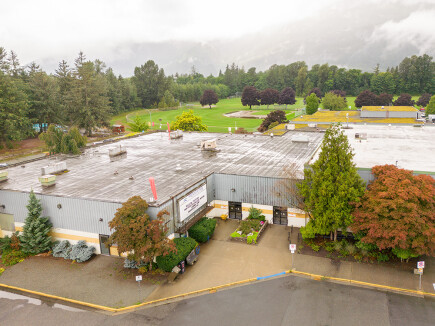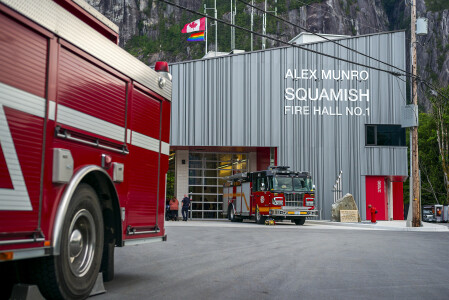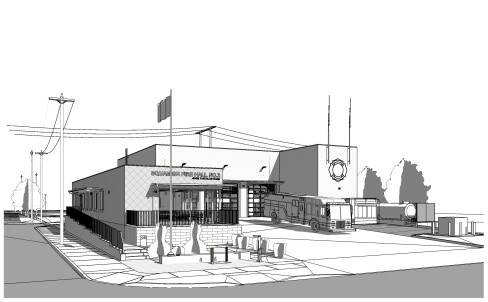Municipal Action
The District of Squamish owns and operates more than 20 buildings and approximately 80 fleet vehicles, and oversees waste collection services. Above and beyond the Community Climate Action Plan (CCAP), we need a customized strategy specific to emissions that the District is responsible for. The Municipal Energy and Emissions Plan aims to reduce municipal emissions to 730 tonnes CO2e per year, or a 68% reduction from 2030 business as usual projections.
View THE MUNICIPAL ENERGY EMISSIONS PLAN
Fleet Electrification
The District of Squamish is working to convert its fleet to electric or low-emissions vehicles. The current fleet includes Chevrolet Bolt Battery Electric Vehicles, a Ford C-Max hybrid vehicle and even an Olympia Ice Bear electric ice resurfacer. By 2024, 90% of new vehicle and light duty truck purchases should be electric equivalents, such as the Ford Lightning.
The construction of a new Public Works yard includes a row of EV charging stations and work is ongoing to increase charging capacity for the District of Squamish electric vehicle fleet as it grows. For example, there are four EV chargers outside the library for fleet vehicles.
Retrofitting Existing Municipal Buildings
The District can reduce emissions by upgrading existing buildings that it owns and operates, such as Brennan Park Recreation Centre, which is currently a significant source of emissions. The facility will soon be undergoing the first stage of upgrades to address community and climate needs.
 Upgrades are expected to reduce energy consumption by 42% and reduce Greenhouse Gas (GHG) emissions by up to 310 tonnes CO2e/year. The project plan includes recovering energy from the ice plant at the ice rink, centralizing heating and chilled water, and utilizing electric heat pumps for efficient temperature control in the building.
Upgrades are expected to reduce energy consumption by 42% and reduce Greenhouse Gas (GHG) emissions by up to 310 tonnes CO2e/year. The project plan includes recovering energy from the ice plant at the ice rink, centralizing heating and chilled water, and utilizing electric heat pumps for efficient temperature control in the building.
Construct Efficient, Low-Carbon New Facilities
Work is underway to replace municipal buildings that are at end-of-life, including the community’s two fire halls. Once this work is completed, the District is expected to reduce facility emissions by between 90% and 95%.
 Construction on Alex Munro Fire Hall No. 1 in Valleycliffe is now complete and the fire hall is operational. The building priorities included reducing operational and embodied carbon emissions. The project exceeded its energy reduction targets, improving efficiency by a further 11.5%, and also lowered GHG more than anticipated, reducing emissions to 2.5 tonnes CO2e per year for the whole building (from original targets of 4.1 tonnes CO2e per year).
Construction on Alex Munro Fire Hall No. 1 in Valleycliffe is now complete and the fire hall is operational. The building priorities included reducing operational and embodied carbon emissions. The project exceeded its energy reduction targets, improving efficiency by a further 11.5%, and also lowered GHG more than anticipated, reducing emissions to 2.5 tonnes CO2e per year for the whole building (from original targets of 4.1 tonnes CO2e per year).
 Construction on Fire Hall No. 2 at Tantalus Road was completed in 2024. The design objective is to achieve Net Zero energy consumption, which means that all of the energy required for the building can be produced on site.
Construction on Fire Hall No. 2 at Tantalus Road was completed in 2024. The design objective is to achieve Net Zero energy consumption, which means that all of the energy required for the building can be produced on site.
In order to achieve Net Zero, the building envelope will be optimized, high efficiency appliances will be used, LED lighting and specific lighting controls will be employed, and a high-performance mechanical system using air source heat pumps will be used. Photovoltaic (solar) panels will be added to the roof of the building to offset energy use.
Local Carbon Registry
The District of Squamish has joined numerous BC municipalities, including Metro Vancouver, as a participant in the Local Carbon Registry (LCR). The LCR allows organizations to showcase actions that reduce local carbon emissions, to track progress to reduce emissions, and to plan pathways to be carbon neutral. Municipal projects like the District’s Residential Organic Waste Diversion and Composting Program and Electric Vehicle charging stations are examples of projects in the LCR.
Squamish is carbon neutral as a municipality, which means that it offsets its corporate emissions. It is important to first do everything you can to reduce emissions before looking to purchase offsets.
